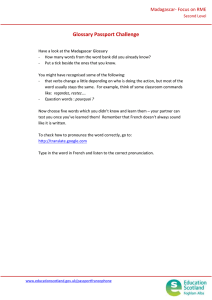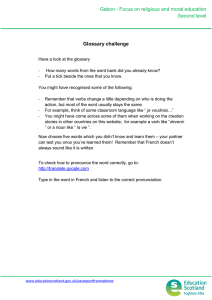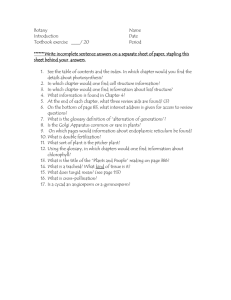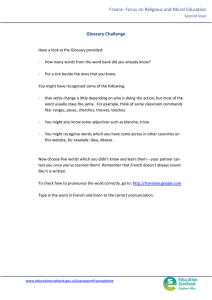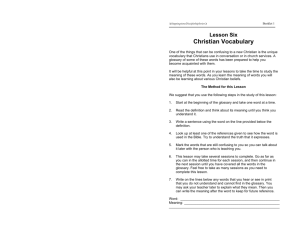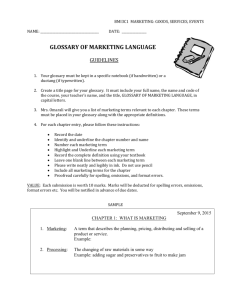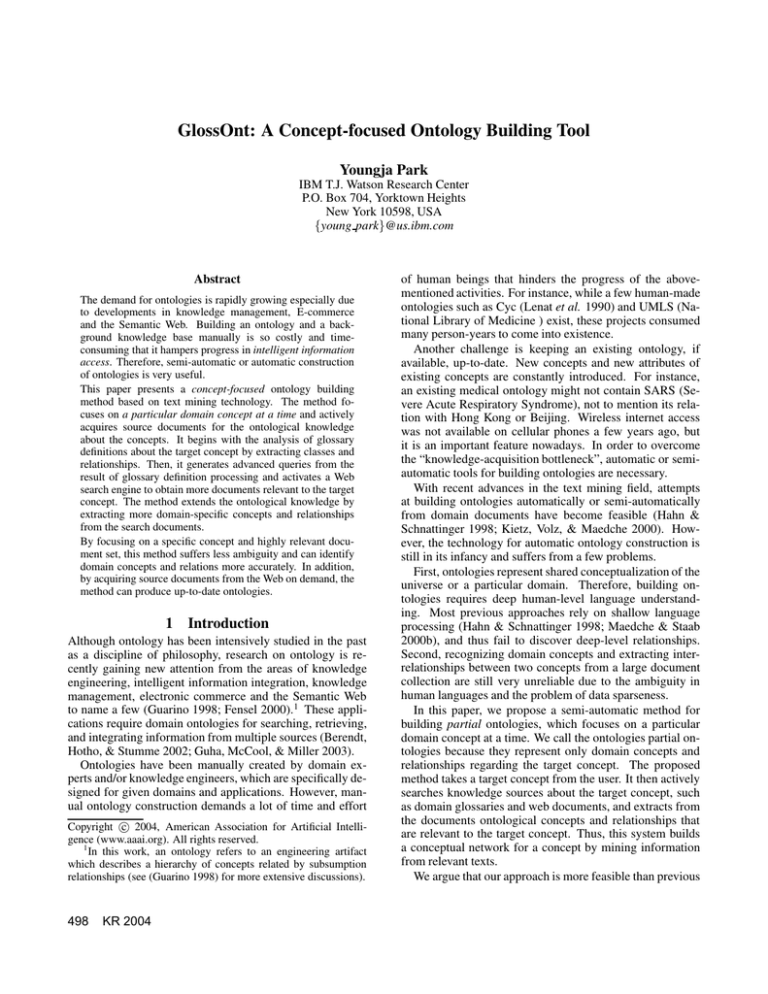
GlossOnt: A Concept-focused Ontology Building Tool
Youngja Park
IBM T.J. Watson Research Center
P.O. Box 704, Yorktown Heights
New York 10598, USA
{young park}@us.ibm.com
Abstract
The demand for ontologies is rapidly growing especially due
to developments in knowledge management, E-commerce
and the Semantic Web. Building an ontology and a background knowledge base manually is so costly and timeconsuming that it hampers progress in intelligent information
access. Therefore, semi-automatic or automatic construction
of ontologies is very useful.
This paper presents a concept-focused ontology building
method based on text mining technology. The method focuses on a particular domain concept at a time and actively
acquires source documents for the ontological knowledge
about the concepts. It begins with the analysis of glossary
definitions about the target concept by extracting classes and
relationships. Then, it generates advanced queries from the
result of glossary definition processing and activates a Web
search engine to obtain more documents relevant to the target
concept. The method extends the ontological knowledge by
extracting more domain-specific concepts and relationships
from the search documents.
By focusing on a specific concept and highly relevant document set, this method suffers less ambiguity and can identify
domain concepts and relations more accurately. In addition,
by acquiring source documents from the Web on demand, the
method can produce up-to-date ontologies.
1 Introduction
Although ontology has been intensively studied in the past
as a discipline of philosophy, research on ontology is recently gaining new attention from the areas of knowledge
engineering, intelligent information integration, knowledge
management, electronic commerce and the Semantic Web
to name a few (Guarino 1998; Fensel 2000).1 These applications require domain ontologies for searching, retrieving,
and integrating information from multiple sources (Berendt,
Hotho, & Stumme 2002; Guha, McCool, & Miller 2003).
Ontologies have been manually created by domain experts and/or knowledge engineers, which are specifically designed for given domains and applications. However, manual ontology construction demands a lot of time and effort
c 2004, American Association for Artificial IntelliCopyright gence (www.aaai.org). All rights reserved.
1
In this work, an ontology refers to an engineering artifact
which describes a hierarchy of concepts related by subsumption
relationships (see (Guarino 1998) for more extensive discussions).
498
KR 2004
of human beings that hinders the progress of the abovementioned activities. For instance, while a few human-made
ontologies such as Cyc (Lenat et al. 1990) and UMLS (National Library of Medicine ) exist, these projects consumed
many person-years to come into existence.
Another challenge is keeping an existing ontology, if
available, up-to-date. New concepts and new attributes of
existing concepts are constantly introduced. For instance,
an existing medical ontology might not contain SARS (Severe Acute Respiratory Syndrome), not to mention its relation with Hong Kong or Beijing. Wireless internet access
was not available on cellular phones a few years ago, but
it is an important feature nowadays. In order to overcome
the “knowledge-acquisition bottleneck”, automatic or semiautomatic tools for building ontologies are necessary.
With recent advances in the text mining field, attempts
at building ontologies automatically or semi-automatically
from domain documents have become feasible (Hahn &
Schnattinger 1998; Kietz, Volz, & Maedche 2000). However, the technology for automatic ontology construction is
still in its infancy and suffers from a few problems.
First, ontologies represent shared conceptualization of the
universe or a particular domain. Therefore, building ontologies requires deep human-level language understanding. Most previous approaches rely on shallow language
processing (Hahn & Schnattinger 1998; Maedche & Staab
2000b), and thus fail to discover deep-level relationships.
Second, recognizing domain concepts and extracting interrelationships between two concepts from a large document
collection are still very unreliable due to the ambiguity in
human languages and the problem of data sparseness.
In this paper, we propose a semi-automatic method for
building partial ontologies, which focuses on a particular
domain concept at a time. We call the ontologies partial ontologies because they represent only domain concepts and
relationships regarding the target concept. The proposed
method takes a target concept from the user. It then actively
searches knowledge sources about the target concept, such
as domain glossaries and web documents, and extracts from
the documents ontological concepts and relationships that
are relevant to the target concept. Thus, this system builds
a conceptual network for a concept by mining information
from relevant texts.
We argue that our approach is more feasible than previous
methods which try to build a full ontology from a collection
of documents for the following reasons. First, the system
intends to focus on a small number of domain concepts that
are described by domain glossaries or by users. Thus, identifying target concepts and relationships in documents can be
more focused and thus easier. Second, glossary definitions
aim at explicitly defining the target concepts. By processing these glossary definitions, we can obtain more semantic
relationships, which are not explicitly expressed in general
documents. Third, we have much less semantic ambiguity in
glossary definitions and search documents because they are
concept-specific documents. This reduced ambiguity makes
the approach more practicable. Fourth, we use a state-ofart domain entity recognition algorithm and a deep syntactic parser contrary to previous approaches which use shallow language processing. This enables us to extract domain
concepts and relationships more accurately. Lastly, this approach can produce more up-to-date ontologies because the
Web reflects creation of new concepts or increased focus on
existing concepts more quickly.
2 Concept-focused Ontology Building
Our system, called GlossOnt, aims to extract domain concepts and relationships from texts which are very relevant to
a target (or anchor) concept. GlossOnt uses a search engine to find relevant document sources about the concept
of interest. A domain entity recognizer identifies domainspecific glossary items from the document collection. Then,
domain concepts that are semantically related to the target
concept are selected from the glossary items. A set of relation extractors find relationships in which at least one of
the recognized domain concepts participate. The relationships include IS-A, PART-OF, HAS-ALIAS, USE and other
relationships expressed by verbs and their arguments.
GlossOnt consists of two phases—domain glossary processing phase and search document processing phase–
according to document types.
In the first phase as shown in Figure 1, GlossOnt analyzes
domain glossaries or dictionaries. A glossary is an alphabetical list of technical terms in a specialized field of knowledge, which usually provides readers with definitions, typical usages and characteristics about domain concepts. Glossaries are very useful domain knowledge resources. For instance, we can find hypernyms and synonyms of terms by
understanding their glosses.
In this work, we consider two possible scenarios. First, a
user already has domain glossaries in the local computer (1)
and GlossOnt processes the glosses one after another (i.e.,
a batch mode). Second, a user provides the system with a
domain term of interest, then the system searches glossary
definitions for the given term on the Internet (2) (i.e., an
online mode). Domain entities are recognized (3) and the
relationships are extracted (4) from the glossary definitions.
Domain glossaries generally provide useful knowledge
(for example, IS-A and PART-OF relations) of the target
concepts. However, they are short in length and thus don’t
provide complete information regarding the target concept.
Thus, we extend our knowledge resource to Web documents
or local domain documents.
After processing glossary definitions for a target concept,
GlossOnt formulates a rich query for the domain concept
(5). The advanced query usually consists of the target term,
its hypernyms and other semantically relevant terms (in general, they are listed as “see also” in glossary).
We use a search engine with the query to acquire a focused document collection which consists only of documents regarding the target concept. If no glossary definition
for a concept is provided or the system fails to find glossary definitions, the system performs Web search (the second step) only with the target term or with a user-provided
extended query.
Figure 2 shows the architecture of the second phase of
GlossOnt. In this phase, GlossOnt reads the query and activates a Web search engine to obtain more document sources.
Traditional keyword-based search engines may return many
irrelevant documents due to semantic ambiguity of query
terms and skewed popularity of certain web pages, for example. However, advanced queries augmented with synonyms, hypernyms and other related terms were proven to
enhance the search results (Cooper & Byrd 1997; Leroy,
Tolle, & Chen 1999; Agirre et al. 2000; Kumar et al. 2001;
AltaVista 2002). Kumar et al. (2001) reports that a query
consisting of the topic title with query augmentations yields
high quality search results with a precision of over 80%.
Agirre et al. (2000) exploits Web documents to enrich a large
lexical database, WordNet (Miller 1990). The system tries to
construct lists of closely related words (topic signature) for
each sense in WordNet. They build a complicated boolean
query from cuewords used in the sense definitions of a word
to retrieve documents that contain the target word and one
of the cuewords of the target concept.
A query formulated from the result of glossary processing
enables the search engine to find a high-quality set of web
documents about the target concept. The system selects the
top n documents returned by the search engine. The value
of n is provided by the user in advance. GlossOnt then tries
to find domain concepts semantically related to the target
query and extracts relationships from the search documents.
Section 3 and section 4 present the algorithms for finding
domain concepts semantically related to the target concept,
and section 5 describes relationship extraction methods in
detail.
3
Domain Entity Recognition
Domain entity recognition identifies words or phrases that
name and describe domain concepts in documents for a particular domain. In this work, we call these domain-specific
terms “glossary items”. Concepts are generally represented
by nouns and verbs in texts. However, recognizing all nouns
and verbs in the given documents is insufficient because
domain-specific documents contain a lot of generic terms as
well as domain terms.
We developed an automatic glossary extraction system
which identifies and organizes glossary items from domain
documents (see (Park, Byrd, & Boguraev 2002) for a complete description). The glossary extraction algorithm consists of four steps: candidate glossary item recognition, pre-
KR 2004
499
(1)
Search
Glossary
Relation
Extractors
Domain Entity
Recognizer
Glossaries
(4)
(3)
Glossary
Item
Query
Generator
(5)
(2)
Domain
Ontology
Queries
Figure 1: Phase I: GlossOnt takes glossary definitions for a target concept from the user’s local storage or from the Web. It
extracts domain concepts and their relationships to build ontologies. It also produces advanced queries from the result of the
analysis of glossary definitions
modifier filtering, glossary item aggregation and confidence
value computation.
Candidate Glossary Item Recognition
We first identify single- and multi-word phrases (up to 6
words) by applying a Finite State Transducer (FST)-based
phrase recognizer. This FST-based recognition is purely
syntactic and is run on part-of-speech (POS) tagged documents. This step recognizes nouns, noun phrases and verbs
since they mainly express concepts.
However, the POS-based term recognition method is
prone to out-of-vocabulary (OOV) words.2 Domain documents tend to contain a lot of OOV words because many
technical words are not found in general corpora or dictionaries. We process these OOV words and decide if an OOV
word is a real word or not on the basis of its morphological
constituents and the entropy of the character sequences in
the word (see (Park 2002) for detailed description for OOV
word processing). If an OOV word is regarded as a real
word, and its POS is decided to be a noun or a verb, it is also
considered as a candidate glossary item.
Pre-modifier Filtering
Pre-modifier filtering distinguishes domain-specific modifiers from generic modifiers. Many domain-specific noun
phrases contain generic modifiers, which do not contribute
to the domain concept. For instance, “psychiatric” in “psychiatric disorder” is domain-specific, but “related” in “related disorder” is not domain-specific. There are two problems in including all pre-modifiers in glossary items. First,
these pre-modifiers weaken the domain specificity of the
glossary items. Second, there may exist many essentially
identical domain concepts with slightly different modifiers.
This step aims to filter out generic modifiers from glossary
2
words that are not found in a given dictionary
500
KR 2004
items to make the glossary items more coherent and domainspecific.
The filtering decision is based on the modifier’s domain
specificity and the association of the modifier and its head
noun. The domain specificity of a word (w) is calculated
by the relative probability of the occurrence of the word in
the given domain text (pd ) versus a general corpus (pc ) as
follows:
domain specif icity(w) =
pd (w)
pc (w)
The association of an adjective (a) and a noun (n) specifies
how likely the head noun is n when a is seen in a glossary
item and is calculated by the conditional probability of the
occurrence of the head noun given the pre-modifier; that is,
p(n|a).
An experiment with a 1-megabyte computer manual
shows that the pre-modifier filtering step reduces 142 different kinds of “server”s into 103 “server”s. We think this
benefit would be greater when we process larger documents.
Glossary Item Aggregation
Glossary item aggregation recognizes different expressions
of a concept and aggregates them into a single glossary item.
A single concept may be expressed in different ways in texts,
such as abbreviations (“nuclear/biological/chemical” and
“nbc”); spelling errors or alternative spellings (“anesthesia”
and “anaesthesia”); and orthographic variants (“AttentionDeficit Hyperactivity Disorder”, “attention deficit hyperactivity disorder” and “attention deficit/hyperactivity disorder”). Aggregation of different expressions of a concept
unifies terminological differences and helps to compute the
domain-specificity of a concept more accurately.
Note that discovering some of the variants is not trivial—
especially abbreviations and misspellings. We developed a
machine-learning approach to recognize abbreviations and
Web
Documents
Domain Entity
Recognizer
Web
Search
Related Concept
Recognizer
Queries
Relation
Extractors
Domain
Ontology
Figure 2: Phase II: GlossOnt activates a Web search with query terms generated in Phase I. It first recognizes domain-specific
entities in the search documents, and then it extracts other domain concepts that are semantically related to the query terms.
Finally, it discovers relationships in which the domain concepts participate
their definitions in documents (Park & Byrd 2001). This algorithm learns abbreviation pattern-based rules from many
examples of abbreviations and their definitions, and applies
the rules to match abbreviations and their full forms in
texts. This algorithm also exploits textual cues (for instance,
phrases such as “for short”, “is acronym of” and patterns
such as “multi-word (single word)”) to recognize new types
of abbreviations which existing abbreviation pattern rules
fail to match.
Misspellings are recognized as follows. First, if a word is
not found in a dictionary, we suppose the word is misspelled.
Then, we retrieve words from the dictionary for which string
edit distance with the misspelled word is less than or equal to
2. String edit distance (also known as Levenshtein distance)
is the smallest number of insertions, deletions, and substitutions required to change one string into another (Levenshtein
1962). If one of these words appears in the document, we
consider the target word as a misspelling of the word.
4 Semantically Related Concept Recognition
This section describes how to choose glossary items that
are semantically related to a target concept. The domain
entity recognition method described in the previous section
may produce many candidate glossary items. For conceptfocused ontology building, we aim to focus on a small number of domain concepts which are strongly related to each
other.
Let the target concept be t, and a candidate glossary item
be g. Our hypotheses for finding glossary items semantically
relevant to t are as follows:
1. t and g share some words.
When two glossary items have some words in common,
the two glossary items can be regarded as sharing some
concept. For instance, if a person is interested in ballistic missile, he may also want to know about short-range
ballistic missile and medium-range ballistic missile.
2. t and g appear together in same sentences. If two glossary
items co-occur often, they may be a semantic indicator for
each other.
Among the glossary items which satisfy the above conditions, we select the final set of domain concepts which have
high frequency and domain specificity. Note that frequency
and domain specificity are computed on aggregated glossary
items. The reason we use domain specificity (a rather complicated measure) as a decision factor is that many high frequency glossary items are generic terms.
We compute the domain-specificity of a glossary item as
the average of the domain specificity of all the words in the
glossary item:
P
Pd (wi )
wi ∈T log Pc (wi )
(1)
|T |
where, | T | is the number of words in glossary item T ,
pd (wi ) is the probability of word wi in a domain-specific
document, and pc (wi ) is the probability of word wi in a general document collection.
Table 1 shows the 30 most relevant domain concepts for
agroterrorism extracted from 100 Web search documents.
The search query was created by processing a glossary definition of agroterrorism in Table 2.
Note that the first phase of GlossOnt, domain glossary
processing, does not have this process. We treat all the glossary items in glossary definitions for a concept as semantically relevant to the target concept. This assumption is reasonable as glossary definitions are specially written to define
the concept.
The following relation extraction procedure only concentrates on this set of glossary items.
KR 2004
501
agriculture
animal
bioterrorism
counter-terrorism
event
food supply
Terror Attack
Terrorist Act
Terrorist motive
Terrorist Incident
agroterrorist attack
Biological Terrorist Attack
bioterrorist attack
crop
farm
homeland security
Terrorist Threat
terrorist group
terrorist organization
United State
al-qaida
attack
chemical
ecoterrorist
food
livestock
terrorism
terrorist
threat
weapon
Table 1: Domain concepts relevant to agroterrorism. These
were extracted from 100 Web documents from a search
query “agroterrorism and terrorist attack”.
5 Relation Extraction
The relation extraction module extracts binary relations such
as “IS-A”, “PART-OF”, “HAS-ALIAS”, and other verbal relations. Verbal relations mean relations represented by verbs
and their arguments. There may be many possible relations
in documents, but we only extract the relations where at least
one of the arguments is the target concept or a glossary item
selected by the process described in the previous section.
We apply a set of different methods for relation extraction
according to the type of relations. For instance, we apply
several light-weight FST-based pattern recognizers for “ISA” relation, and a deep syntactic parser for extracting verbal
relations. The following sections describe how to extract
these relations. Throughout this section, we use a glossary
definition in Table 2 as our example text.
agroterrorism .
Terrorist attacks aimed at reducing the food supply by
destroying crops using natural pests such as the potato
beetle, animal diseases such as hoof and mouth disease
and anthrax, molds and other plant diseases, or chemicals
that defoliate vegetation, such as Agent Orange.
Table 2: A glossary definition for agroterrorism
IS-A Relation
This section describes three different ways for extracting ISA, or hypernym/hyponym relation. In this work, we don’t
distinguish “classes” and “instances”; thus, throughout this
paper, IS-A relation includes INSTANCE-OF relation. In
future work, we will investigate a method for automatically
distinguishing classes and instances.
Lexico-syntactically suggested IS-A relations: Some
linguistic patterns indicate hypernym/hyponym relations
and appear frequently enough to be useful. The first major attempt to automatically extract hyponymy relations of
terms from text was that of (Hearst 1992). It presents a set of
lexico-syntactic patterns that indicate a hyponymy relation.
These patterns occur frequently and in many text genres, and
can be recognized with not-very-complex text analytics.
502
KR 2004
Table 3 shows the lexicon-syntactic patterns for IS-A relations. We added more patterns which occur frequently
in Web documents in addition to the patterns proposed
in (Hearst 1992).
1.
2.
3.
4.
such noun0 as noun1 , noun2 ,..., {and|or} nounn
noun0 such as noun1 , noun2 ,..., {and|or} nounn
noun0 {including|especially} noun1 ,...,{and|or} nounn
noun1 , noun2 ,..., nounn {and|or} other noun0
5. noun1 is {a|the} {kind | type} of noun0
6. noun1 is a {term|word|concept}
{[used] to verb|for verb-ing} noun0
7. noun0 except noun1 , noun2 ,..., {and|or} nounn
Table 3:
The lexico-syntactic patterns for hypernym/hyponym relationship. The patterns indicate that
nouni , 1 ≤ i ≤ n, are hyponyms of noun0 .
When these syntactic patterns occur in text (either search
documents or glossaries), we find that the nouni , 1 <=
i <= n, are hyponyms of noun0 . In these patterns, note
that at least one of nouni belongs to the set of glossary items
semantically related to the target concept.
However, purely pattern-based IS-A relation extraction is
not very accurate. Hearst (1992) reports that 52% of relations extracted by the “and|or other” pattern were judged
to be good when the pattern was extracted from the text
of Grolier’s Encyclopedia. Another evaluation with general texts shows worse performance. Cederberg & Widdows (2003) applies the same set of patterns as in (Hearst
1992) in the British national Corpus (BNC) and reports 40%
of the relations extracted were exactly correct, or would be
correct with the use of minor post-processing consisting of
lemmatization and removal of common types of modifier
words. Cederberg & Widdows (2003) suggests a method
for filtering out less similar hypernym and hyponym pairs;
thus, enhancing precision but reducing recall.
A frequent reason for incorrect hyponymy relations is
that the real hypernym appears several words away from the
cue phrases. In other words, noun0 in Table 3 is not always
the hypernym, but we need to look at wider context to find
the correct hypernym. Based on our manual inspection of
2000 sentences, we set the window to 3 noun phrases. For
instance, the second pattern in Table 3 extends as follows:
noun−2 , · · · , noun−1 , · · · , noun0 such as
noun1 , noun2 , · · · , {and | or} nounn .
More formally, for the extended patterns, we compute the
similarity of nouni (from i = 1 to n) and nounj , −2 ≤ j ≤
0, and decide nounj with the highest similarity with nouni
to be the hypernym of noun1 , . . . , nounn . If the decision is
not made, noun0 is selected to be the hypernym.
We compute the similarity of nouni and nounj ,
S(nouni , nounj ), by using a Web search engine. The notion is that if nounj is the correct hypernym of nouni , then
nounj and nouni would appear together in those patterns
in Table 3 (i.e., local context) more often than other nouns.
We can confidently reach this conclusion if we have enough
of these examples to justify it. The largest textual resource
is the Web since many Web search engines index billions
of web pages. We submit the following three queries to a
search engine and choose nounj with the most search documents returned by the search engine.
Q1 : noun0 such as nouni
Q2 : noun−1 such as nouni
Q3 : noun−2 such as nouni
From the example gloss in Table 2, the system extracts the
following 6 IS-A relationships.
potato beetle
hoof
mouth disease
anthrax
mold
Agent Orange
IS-A
IS-A
IS-A
IS-A
IS-A
IS-A
natural pest
animal disease
animal disease
animal disease
plant disease
chemical
Note that GlossOnt identifies chemical rather than vegetation as the hypernym of Agent Orange. However, the system
makes a mistake for this example due to syntactic ambiguity
in the sentence. The system identifies hoof and mouth disease as two different domain concepts, but in fact hoof and
mouth disease is a domain concept.
Structurally suggested IS-A relations: The genus term
(i.e., the head noun of the first sentence) of a gloss usually
represents the hypernym of the defined term (Vossen, Meijs,
& den Broeder 1989). If a given document is a glossary
definition, the system processes the first sentence to find the
genus term. If there is no other indication for another relation, the genus is determined as the hypernym of the gloss
term. For instance, the genus term in the example text is
terrorist attack and we conclude that agroterrorism is a terrorist attack.
The common structures in which genus terms are found
are:
• noun0 which ....
• A {kind|type|category} of noun0 ...
• A {term|concept} { [used] to verb|for verb-ing} noun0 ...
When these patterns are found in a glossary definition,
noun0 is regarded as the hypernym of the target concept.
The above patterns are also used for extracting IS-A relations from search documents as explained in the next section.
Lexically suggested IS-A relations: Hyponymy relations
can also be found by analyzing multi-word noun phrases.
When noun phrases contain one or more modifiers, the modifiers tend to add additional semantic attributes or restrictions to the head noun. Especially, adjectival modifiers usually introduce a hyponymic relation (Bodenreider, Burgun,
& Rindflesch 2001).
We treat the head noun and the noun phrase as hypernym
and hyponym relation. For instance, we conclude that psychiatric disorder IS-A disorder and terrorist attack IS-A attack by applying this heuristic.
5.2
Alias Relation
This relation specifies alternative names for a concept. The
HAS-ALIAS relationship in this work is not the same as the
synonymy relationship in a strict sense (for instance, “robber” is a synonym of “thief”) but it specifies a subset of the
synonymy relationship.
Abbreviations are the most common examples of the
HAS-ALIAS relation. The system for matching abbreviations and their definitions (Park & Byrd 2001), which was
described in section 4, is used for this purpose too. We consider an abbreviation and its definition as aliases for each
other. For example, International Business Machines HASALIAS IBM.
In addition to abbreviations, we apply lexico-syntactic
patterns for recognizing other aliases. The patterns are
“noun1 ... [also] {known | called } as noun2 ” as shown
in the following examples.
• Zomig, formerly known as 311C90
• 3,4-methylenedioxymethamphetamine (also known as
“Ecstasy”)
When these patterns appear in text, we find that noun1 and
noun2 are aliases. Note that the HAS-ALIAS relation is
symmetric.
5.3
Verbal Relations
Verbal relations mean relations represented by verbs and
their arguments. Syntactic structures are distinct from semantic structures. Nevertheless, syntactic dependency relations coincide closely with semantic relations between the
entities (Maedche & Staab 2000a; Gamallo. et al. 2002).
In general, lexical items, which express predicate relations,
take, as their syntactic dependents, nominal expressions
which name the predicate’s arguments. These predicateargument structures can often be interpreted as expressing
relationships. A common example is that the subject and the
object of a verb are the participants in the relation expressed
by the verb.
We find the dependency relations in which the target concept or one of the selected glossary items appear and generate the relations named with the verbs. We process documents with a deep syntactic parser (McCord 1980) to obtain grammatical dependency relations of constituents and
to recognize patterns for relations.
In our example gloss, the following 6 verbal relations are
recognized:
agroterrorism
agroterrorism
agroterrorism
agroterrorism
agroterrorism
agroterrorism
agroterrorism
REDUCE
DESTROY
USE
USE
USE
USE
USE
food supply
crop
natural pest
animal disease
plant disease
mold
chemical
Finally, Figure 3 shows the domain entities and the relationships extracted from the glossary definition in Table 2 by
the methods described in section 4 and section 5.
KR 2004
503
food supply
reduce
attack
IS-A
crop
destroy
natural pest
use
animal disease
terrorist
attack
use
use
IS-A
use
IS-A
hoof
IS-A
mouse disease
IS-A
anthrax
plant disease
IS-A
mold
use
agroterrorism
potato beetle
IS-A
chemical
IS-A
Agent Orange
Figure 3: Domain concepts and relations extracted from a glossary definition for agroterrorism in Table 2
While these verbal relations represent relationships between domain concepts, it is unclear at this time how these
verbal relations would be incorporated in the ontology.
6 Related Work
In this section, we briefly discuss previous efforts to construct or maintain ontologies (semi-)automatically from text.
Hahn & Schnattinger (1998) introduce a methodology for
automating the maintenance of domain-specific taxonomies
based on natural language text understanding. It starts with
an ontology and incrementally updates the ontology as new
concepts are acquired from text. Especially, the system
records unknown lexical items occurring in certain syntactic constructions (genetive, apposition and verb case frame),
and decides if the concept for the new lexical item should
be added based on the concept hypotheses. The hypothesis
space of possible generalizations for a new unknown concept is initialized as any possible concept in the ontology
(e.g., the top concept). When the new concept is seen with
more concept hypotheses, the system shrinks that hypothesis
space. This system augments an ontology with newly found
instances and classes but no attempt has made for extracting
relationships.
Kietz, Volz, & Maedche (2000) present a cyclic process
for extending an existing ontology with the results of processing a domain-specific dictionary and corporate intranet
documents. The system starts with a generic ontology (they
actually use a lexical-semantic net called GermaNet). It acquires domain-specific concepts and their taxonomic embedding from domain-specific documents. The newly acquired concepts are added into the generic ontology and all
unspecific concepts are removed from the ontology. The system also introduces new conceptual relationships between
concepts. This system is similar to the proposed system in
this paper in that it also processes a dictionary of corporate
terms and applies the lexico-syntactic patterns to find taxonomic relations. However, this system simply converts the
headwords in the dictionary into concepts, and does not have
504
KR 2004
an automatic domain concept recognition system from text.
Most previous approaches for automatic ontology construction concentrate only on identifying taxonomic relations (e.g., IS-A relation) by using statistical or linguistic information (Hahn & Schnattinger 1998; Hearst 1992;
Pereira, Tishby, & Lee 1993). Maedche & Staab (2000a)
presents a method for finding non-taxonomic conceptual relations based on co-occurrence information. Their method
finds concept correlations based on co-occurrence statistics
of two concepts in domain-specific text. It uses a data mining algorithm for discovering generalized association rules
proposed by (Srikant & Agrawal 1995) to find associations
between concepts and the appropriate level of abstraction for
new relations. However, the relationships remain unnamed;
that is, it finds if two concepts are related but it does not tell
how they are related to each other. In this work, we discover
named relationships between domain concepts.
Systems for automatically building semantic lexicons (Roark & Charniak 1998; Riloff & Jones 1999; Thelen
& Riloff 2002) don’t intend to construct ontologies. However, they are also useful for extending existing ontologies.
These systems take as input several seed words for a target
concept and use bootstrapping algorithms to find new words
which supposedly belong to the same category with the seed
words.
7
Conclusion
We presented a semi-automatic tool for building partial ontologies from domain glossaries and Web search documents
which were obtained on-the-fly. We first run a glossary
extraction tool for recognizing domain entities and select
glossary items relevant to the target concepts based on cooccurrence information. Then, we apply deep syntactic parsing as well as shallow syntactic pattern matching to extract
relationships in which the target concepts and the selected
glossary items participate.
This approach differs from other approaches in that it focuses on one domain concept at a time and it obtains re-
lated source documents on demand. Therefore, this conceptfocused approach bears several advantages over previous approaches. First, it is a light-weight tool for extracting information for a specific concept, which the user cares about
at the time. Second, it produces an up-to-date ontology because it obtains source documents on demand from the Web,
which is dynamically changing. Third, it suffers from less
semantic ambiguity because the knowledge source is a set
of relevant documents to the target concept, which are collected by a search engine with advanced queries.
In future work, we plan to investigate non-verbal binary
relations and unary relations or properties. Non-verbal binary relations are relations expressed in noun phrases, for
example, X is the wife of Y or Y’s wife X for “WIFE-OF” OR
“SPOUSE-OF” relation. Unary relations or properties of a
concept usually specify characteristics of the concept, such
as color, length, and so on. These are generally present as
modifiers of nouns or as predicates of the verb to–be. For instance, from “Al Abbas is a 950 km maximum range ballistic
missile”), we want to extract Al Abbas HAS-MAXRANGE
950 km in addition to Al Abbas IS-A ballistic missile.
Most of the technologies described in this paper have been
independently evaluated. However, a remaining challenge is
to design and perform evaluations of the system as a whole
and the quality of ontologies built by the system.
Finally, an automatic mechanism to identify and resolve
contradictory information from different knowledge sources
would be desirable. Currently, we entrust domain experts or
ontology engineers to resolve the problems.
Acknowledgments
This work is supported by the Advanced Research and Development Activity under the Novel Intelligence and Massive Data (NIMD) program PNWD-SW-6059. I also thank
Christopher Welty, Frank Elio and the anonymous reviewers
for their comments that much improved the final manuscript.
References
Agirre, E.; Ansa, O.; Hovy, E.; and Martinez, D. 2000.
Enriching very large ontologies using the www. In Proceedings of the Ontology Learning Workshop, ECAI.
AltaVista. 2002. Altavista prisma. http://www.
altavista.com/prisma.
Berendt, B.; Hotho, A.; and Stumme, G. 2002. Towards
semantic web mining. In Proceedings of International Semantic Web Conference (ISWC02).
Bodenreider, O.; Burgun, A.; and Rindflesch, T. C. 2001.
Lexically-suggested hyponymic relations among medical
terms and their representation in the umls. In Proceedings
of Terminology and Artificial Intelligence (TIA’2001), 11—
21.
Cederberg, S., and Widdows, D. 2003. Using lsa and noun
coordination information to improve the precision and recall of automatic hyponymy extraction. In Proceedings of
Conference on Natural Language Learning (CoNLL), 111–
118.
Cooper, J., and Byrd, R. J. 1997. Lexical navigation: visually prompted query expansion and refinement. In Proceedings of the second ACM international conference on
Digital libraries, 237–246.
Fensel, D. 2000. Ontologies: Silver Bullet for Knowledge
Management and Electronic Commerce. Springer-Verlag.
Gamallo., P.; Gonzalez, M.; Agustini, A.; p. Lopes, G.;
and de Lima, V. S. 2002. Mapping syntactic dependencies
into semantic relations. In Workshop OLT’02 (ECAI’02),
15–22.
Guarino, N. 1998. Formal ontology and information systems. In Proceedings of FOIS’98, 3–15.
Guha, R.; McCool, R.; and Miller, E. 2003. Semantic
search. In Proceedings of WWW2003.
Hahn, U., and Schnattinger, K. 1998. Ontology engineering via text understanding. In Proceedings of the 15th
World Computer Congress.
Hearst, M. 1992. Automatic acquisition of hypernyms
from large text corpora. In Proceedings of the Fourteenth
International Conference on Computational Linguistics.
Kietz, J.-U.; Volz, R.; and Maedche, A. 2000. Extracting
a domain-specific ontology from a corporate intranet. In
Proceedings of the Fourth Conference on Computational
Natural Language Learning and of the Second Learning
Language in Logic Workshop.
Kumar, R.; Raghavan, P.; Rajagopalan, S.; and Tomkins,
A. 2001. On semi-automated web taxonomy construction. In Fourth International Workshop on the Web and
Databases (WebDB’2001).
Lenat, D.; Guha, R. V.; Pittman, K.; Pratt, D.; and Shepherd, M. 1990. Cyc: Toward programs with common
sense. Communications of the ACM 33(8):30–49.
Leroy, G.; Tolle, K. M.; and Chen, H. 1999. Customizable and ontology-enhanced medical information retrieval
interfaces. Proceedings of IMIA Working Group 6 Medical
Concept Representation and Natural Language Processing.
Levenshtein, V. 1962. Binary codes capable of correcting
deletions, insertions and reversals. Soviet Physics Doklady
10(8):707–710.
Maedche, A., and Staab, S. 2000a. Discovering conceptual
relations from text. In Proceedings of ECAI.
Maedche, A., and Staab, S. 2000b. Semi-automatic engineering of ontologies from text. In Proceedings of Software
Engineering and Knowledge Engineering.
McCord, M. C. 1980. Slot grammars. American Journal
of Computational Linguistics (1):255–286.
Miller, G. 1990. Wordnet: an on-line lexical database.
International Journal of Lexicography 3(4).
National Library of Medicine. Unified medical language system (umls). http://www.nlm.nih.gov/
research/umls.
Park, Y., and Byrd, R. J. 2001. Hybrid text mining for
matching abbreviations and their definitions. In Proceedings of Empirical Methods in Natural Language Processing, 126–133.
KR 2004
505
Park, Y.; Byrd, R. J.; and Boguraev, B. K. 2002. Automatic
glossary extraction: Beyond terminology identification. In
Proceedings of the Nineteenth International Conference on
Computational Linguistics.
Park, Y. 2002. Identification of probable real words: An
entropy-based approach. In Proceedings of ACL Workshop
on Unsupervised Lexical Acquisition, 1–8.
Pereira, F. C. N.; Tishby, N.; and Lee, L. 1993. Distributional clustering of english words. In Proceedings of the
Annual Meeting of the Association for Computational Linguistics, 183–190.
Riloff, E., and Jones, R. 1999. Learning dictionaries for information extraction by multi-level bootstrapping. In Proceedings of the Sixteenth National Conference on Artificial
Intelligence.
Roark, B., and Charniak, E. 1998. Noun-phrase cooccurrence statistics for semi-automatic semantic lexicon
construction. In Proceedings of COLING-ACL’98.
Srikant, R., and Agrawal, R. 1995. Mining generalized
association rules. In Proceedings of VLDB’95, 407–419.
Thelen, M., and Riloff, E. 2002. A bootstrapping method
for learning semantic lexicons using extraction pattern contexts. In Proceedings of the 2002 Conference on Empirical
Methods in Natural Language Processing.
Vossen, P.; Meijs, W.; and den Broeder, M. 1989. Meaning
and structure in dictionary definitions. In Boguraev, B., and
Briscoe, T., eds., Computational Lexicography for Natural
Language Processing, 171–192. Longman.
506
KR 2004

